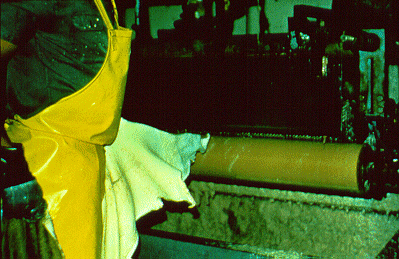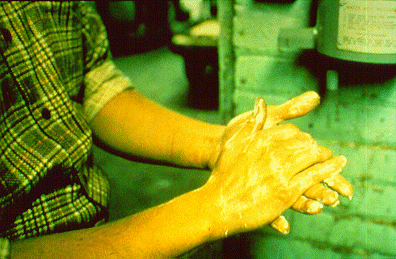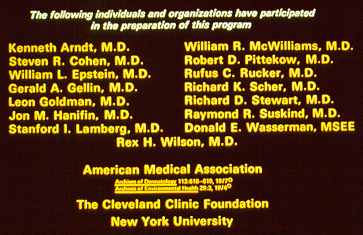Occupational Dermatoses
NOTE: This page is archived for historical purposes and is no longer being maintained or updated.
Slides 111 to 113
Slide 111 - Personal protective

Protective gear generally includes aprons, coveralls, caps and hairnets, smocks, sleeves, shoes and gloves. Synthetic rubber protects the hands against acids and alkalies; neoprene dipped cotton materials protect against most other liquid irritants.
Slide 112 - Barrier creams

Barrier creams designed for specific hazards also offer a certain amount of protection, but they should never be sustituted for special gear.
Slide 113 - Credits

Skin diseases of occupational origin outnumber all other work-incurred illnesses. Early all other work-incurred illnesses. Early recognition and preventive measures can effectively reduce the incidence of occupational dermatoses in the United States.
The following individuals and organizations have participated in the preparation of this program.
- Kenneth Arndt, M..D.
- Steven R. Cohen, M..D.
- William L. Epstein, M.D.
- Gerald A. Gellin, M.D.
- Leon Goldman, M.D.
- Jon M. Hanifin, M.D.
- Stanford I. Lamberg, M.D.
- William R. McWilliams, M.D.
- Robert D. Pittekow, M.D.
- Rufus C. Rucker, M.D.
- Richard K. Scher, M.D.
- Richard D. Stewart M.D.
- Raymond R. Suskind, M.D.
- Donald E. Wasserman, MSEE
- Rex H. Wilson, M.D.
- American Medical Association
- Archives of Dermatology 113:616-619, 1977©
- Archives of Environmental Health 29:3, 1974©
- The Cleveland Clinic Foundation
- New York University
- Page last reviewed: January 5, 1998 (archived document)
- Content source:
- National Institute for Occupational Safety and Health Health Effects Laboratory Division (HELD)


 ShareCompartir
ShareCompartir